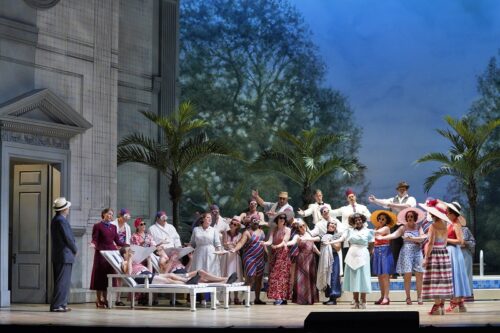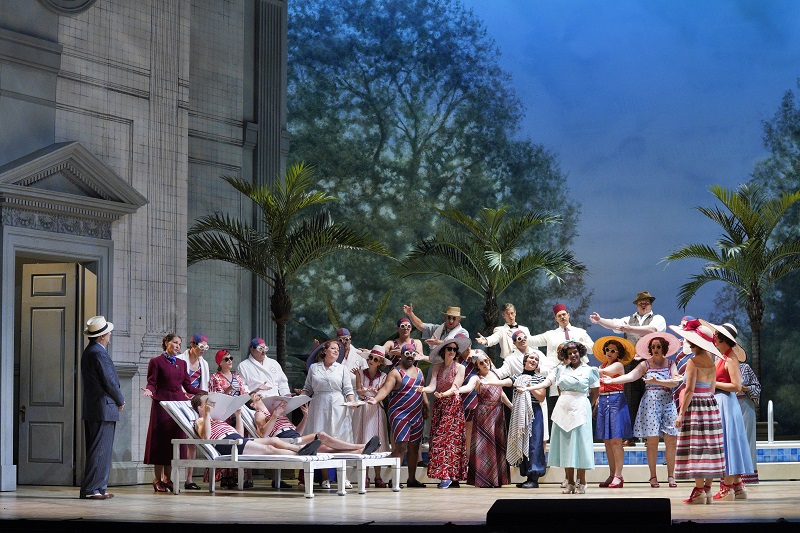 United States Mozart, Così fan tutte: Soloists, Chorus and Orchestra of San Francisco Opera / Henrik Nánási (conductor). War Memorial Opera House, San Francisco, 21.11.2021. (HS)
United States Mozart, Così fan tutte: Soloists, Chorus and Orchestra of San Francisco Opera / Henrik Nánási (conductor). War Memorial Opera House, San Francisco, 21.11.2021. (HS)

Production:
Director – Michael Cavanagh
Sets – Erhard Rom
Costumes – Constance Hoffman
Lighting – Jane Cox
Cast:
Fiordiligi – Nicole Cabell
Dorabella – Irene Roberts
Ferrando – Ben Bliss
Guglielmo – John Brancy
Don Alfonso – Ferruccio Furlanetto
Despina – Nicole Heaston
Così fan tutte, the second leg of San Francisco Opera’s Mozart-Da Ponte project, reached the stage Sunday afternoon with a captivating and innovative production that updated the action to a country club in 1930s America. Pitch-perfect direction, superb conducting from Henrik Nánási, responsive playing from the orchestra and a charming cast combined to make it work. It scores a hit on many levels.
Director Michael Cavanagh ties together the three operas in which Wolfgang Amadeus Mozart collaborated with Lorenzo Da Ponte by setting them near Washington, D.C., in the same mansion at three points in American history. The 2019 season brought Le Nozze di Figaro in the almost-completed house just after the American Revolution. Don Giovanni, the third installment, arrives next season with the building crumbling in a dystopian future 300 years later.

This opera finds the completed abode refashioned into the Wolfbridge Country Club, a luxurious refuge for the rich in the 1930s. It’s a perfect location for the privileged Fiordiligi, Dorabella, Ferrando and Guglielmo as they play out a bet over who can be true romantically to whom. Don Alfonso, portrayed as the club’s manager in a double-breasted suit, wagers that the boys’ sweethearts are not as steadfast as they think, and he enlists Despina, a maid on his staff apparently assigned to the young women, to help fool them.
The staging addresses the misogynistic overtones in Alfonso getting the boys, disguised as foreigners, to woo each other’s partners. The characters overplay scenes for melodrama and slapstick comedy, which only adds gravitas to the moments when they realize the joke has become serious. In the end, the young women are clearly onto the ruse, and they make their own choices about what to do about it. Having overheard the boys paying off the bet with Alfonso, they switch partners again for the sham wedding and end up leaving the boys altogether.
Tweaks to the projected supertitles translate much of the libretto freely and colloquially, which refreshes the few details that don’t quite align with Da Ponte’s Italian.
The entire cast won over the audience. They looked their parts, acted them with ease and bubbled over with chemistry. Costume designer Constance Hoffman outfitted the young lovers colorfully, with perky dresses and pants suits for the girls and outlandish lounge-lizard attire and bathing suits for the boys as ‘Albanians’.
Their singing was good enough, but it won’t make anyone forget some of greats who have performed these roles. The best ensembles were the ones that required them to sing out, as in the finales of both acts, although ‘Soave sia il vento’, the gorgeous trio in Act I, never quite jelled.
Veteran bass-baritone Ferruccio Furlanetto, a steadfast center of gravity, commanded every nuance in Don Alfonso’s music. His resonant sound had the heft to carry over the orchestra, and his presence anchored every scene that he was in.
The other standout was Ben Bliss as Ferrando: a high tenor and endless breath control made highlights of his two big arias. ‘Un’aura amorosa’ spun itself out with ravishing tone and poise, and ‘Tradito, schernito’ conveyed the character’s angst in Act II when he realizes the other guy got his girl.
John Brancy invested Guglielmo with plush tone and commendable musicality, especially in the rarely heard ‘Rivolgete a lui lo sguardo’, the original aria for the character who, disguised as an Albanian, tries convince the women to pay more attention to him and Ferrando. (The shorter ‘Non siate ritrosi’ is usually substituted for this longer, more specific aria.)
Soprano Nicole Heaston, who was a noble Countess in the 2019 Figaro, succeeded in defining Despina’s perkier aspects. Even if the music of ‘Una donna a quindici anni’ never quite bubbled up the way it can, she enhanced scene after scene by investing a certain dry wit into the dialogs and recitatives.
The attractive voices of Nicole Cabell as Fiordiligi and Irene Roberts as Dorabella, both singing these roles for the first time, tended to fade into the background at points. Cabell was fine when singing in the higher soprano range, but the critical low notes all but disappeared in the arias ‘Come scoglio’ and ‘Per pietà’. Mezzo-soprano Roberts’ sound nailed the mock heroics of ‘Smanie implacabili’, but the lilt of ‘É amore un ladroncello’ did not skip quite as lightly as it could have.
Their voices blended well. They were remarkably close in timbre, and it took a few scenes to differentiate them. Color-coded costumes helped. But something happened in ‘Soave sia il vento’ that kept the trio with Furlanetto from achieving the expected seamless moment of perfection.
No complaints for the orchestra, which played with refinement and rhythmic animation under Nánási, who had also conducted the Nozze in 2019. This was apparent from the first bars of the overture, played against a projection of an invitation being written from Alfonso to club members inviting them to a week of dining and dancing in early June. The music and the projection set the scene nicely.
Kudos too to Bryndon Hassman, who accompanied the recitatives on fortepiano.
With few cuts and extra bits such as the longer baritone aria, this production clocked in at a hefty 3 hours 25 minutes, yet the audience never seemed to get restless. It’s a credit to the vitality of the cast and Nánási’s deftly propulsive conducting, but most definitely to Cavanagh’s juicy, revelatory direction, with smile- inducing surprises at almost every turn.
Harvey Steiman
